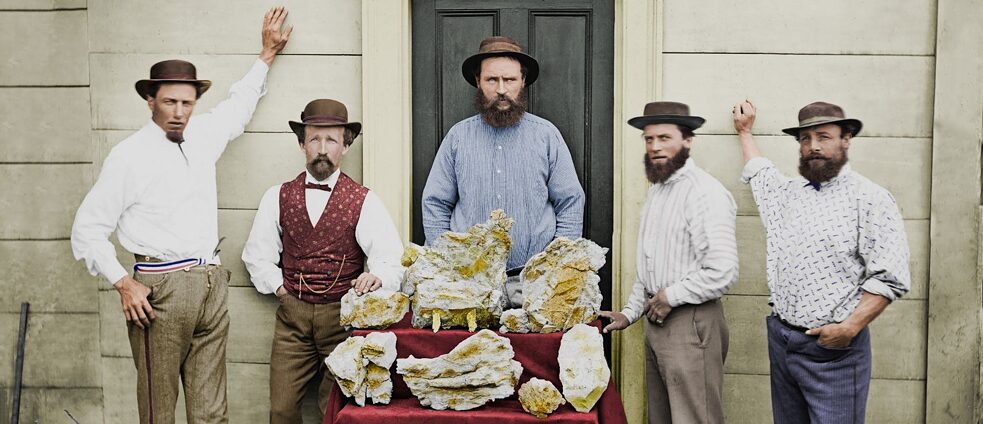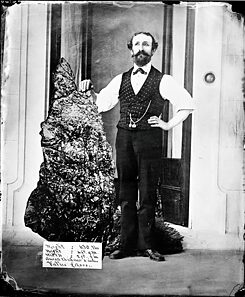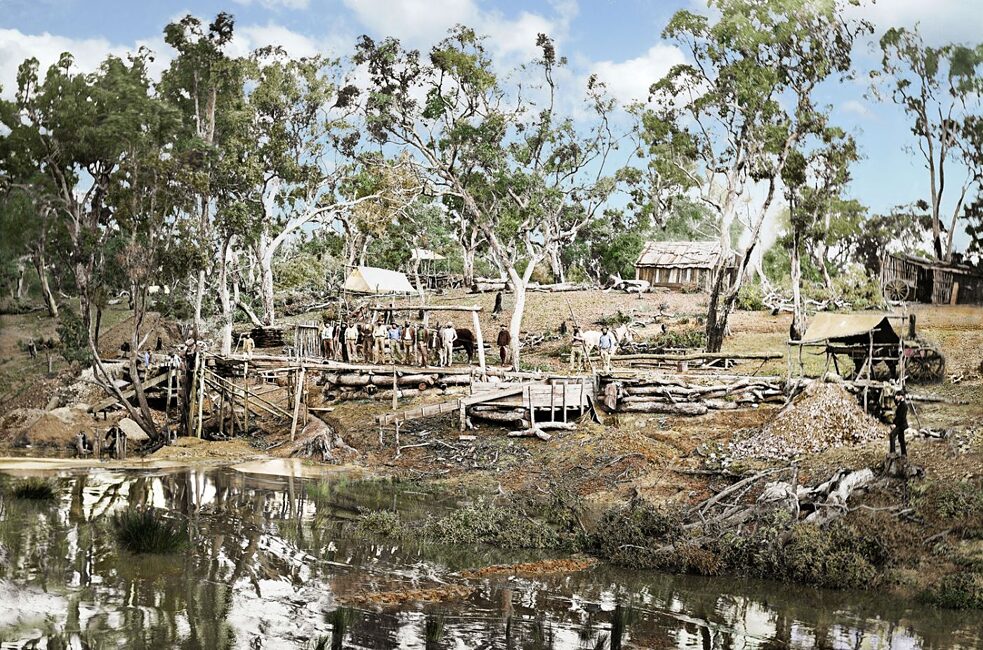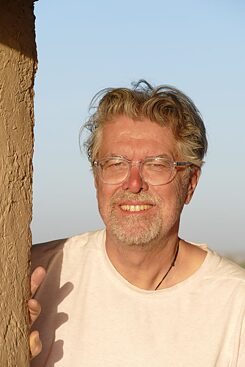New publication
Bernhard Holtermann: A life of many chapters

Arriving as a German migrant to Australia in the late 1850s, Bernhard Holtermann was a man of many talents – ranging from arts philanthropist to gold digger. A newly released book by German journalist Christoph Hein documents his varied, pioneering life and shows Holtermann’s famous photo collection in all its glory.
By André Leslie
Although he worked his way up to becoming a State Parliament politician, toured the world praising the progress of his newly adopted homeland and developed his own “life-preserving drops”, Bernhard Holtermann will always be best known in Australia for his memorable gold discovery, the Holtermann Nugget.
The iconic photo of the diminutive German standing beside the 286-kilogram lump of gold features in the Holtermann Collection held by the State Library of New South Wales. Despite its name, most of the 3500 photos in the collection were taken by photographers Charles Bayliss and Beaufoy Merlin. Some may also have been taken by Holtermann himself, who was a lifelong admirer of new technologies.
 Bernhard Holtermann poses with the famous Holtermann Nugget
| Photo courtesy: State Library of New South Wales
Christoph Hein’s new book Australia 1872: How Bernhard Holtermann turned gold into a unique photographic treasure tells the story of Holtermann’s life and features never-before published photos from the era. Hein talked about Holtermann and the process of writing the book with Goethe-Institut Australia’s online editor André Leslie.
Bernhard Holtermann poses with the famous Holtermann Nugget
| Photo courtesy: State Library of New South Wales
Christoph Hein’s new book Australia 1872: How Bernhard Holtermann turned gold into a unique photographic treasure tells the story of Holtermann’s life and features never-before published photos from the era. Hein talked about Holtermann and the process of writing the book with Goethe-Institut Australia’s online editor André Leslie.
After arriving in Australia from Hamburg in his early 20s, Bernhard Holtermann seemed to get involved in many aspects of Australian society. Would you describe him as multi-talented?
Yes, he had so many layers and some were clearly wrong about him. The famous Australian artist Donald Friend wrote about him quite negatively, saying that he was arrogant and too self-confident. That needs a very special reading of the notes and documents that we have from that time. I don’t share his view, obviously.
I think Holtermann always knew how he could get an advantage from what he was doing, but that’s okay because he did so much in the public’s favour. He warned people of buying shares in mines that later collapsed, though he himself got very rich by having shares in these mines. But he foresaw that they would collapse in the future. He became an elected politician and advocated for immigration in the same way that we could do today and had a very progressive approach. In the 1880s he gave his own money for building a bridge, which later became the Sydney Harbour Bridge. Yes, he looked out for his own advantage, but he always had the general public in mind. I think we can say that with certainty now.
In Australia and especially in Germany, it seems like Holtermann’s achievements have been a bit forgotten. Would you agree?
I would completely agree. In Australia, there are the people at the Gulgong Holtermann Museum and there are those in (the New South Wales country town) Hill End that still live in the same spirit. There are also some new, younger Australian artists working with the photos in the Holtermann Collection. Artist Chris Dingle, who lives in Sydney, does fantastic work on colouring these photos for example. It is unbelievable what you see in these photos if you start colouring the work.
 Chris Dingle's re-coloured prints in Hein's new book show Australia's Gold Rush era
| Copyright: Chris Dingle for Gulgong Holtermann Museum
In Germany Holtermann is not known at all. For example, I found a photo album of the pictures that Bayliss probably did for Holtermann in a museum in Hamburg. It was there but no-one knew really what it was or how it got there. You come across dozens of stories like that, if you follow in Holtermann’s footsteps. It is unbelievable that he is simply not known at all. It was certainly time for someone to write about him for a German audience. Australia has had a number of publications about him and some experts are very knowledgeable about Bayliss and Holtermann, but many of the publications are getting older now. For this book, I was also able to do a lot of research across Germany, in German, which means it presents new information to an Australian audience.
Chris Dingle's re-coloured prints in Hein's new book show Australia's Gold Rush era
| Copyright: Chris Dingle for Gulgong Holtermann Museum
In Germany Holtermann is not known at all. For example, I found a photo album of the pictures that Bayliss probably did for Holtermann in a museum in Hamburg. It was there but no-one knew really what it was or how it got there. You come across dozens of stories like that, if you follow in Holtermann’s footsteps. It is unbelievable that he is simply not known at all. It was certainly time for someone to write about him for a German audience. Australia has had a number of publications about him and some experts are very knowledgeable about Bayliss and Holtermann, but many of the publications are getting older now. For this book, I was also able to do a lot of research across Germany, in German, which means it presents new information to an Australian audience.
Photos seem to have been very important to Holtermann. Despite all the different things he did in his life, it feels like photography was his real passion?
I think you are right. Holtermann seems to have been really interested in new technology, he was an entrepreneur. He wanted to carry the news around the world – and he literally did - about how developed the colony of Australia was in those years. It was no longer just a place for former prisoners. The way to do that in those years was via photos. He saw photography as the right tool to tell the story about Australia and that’s what he did. He also created a pharmaceutical company and he was in import-export of the newest machines. Holtermann always recognised the possibilities of making a better name of himself. He became famous, but he got famous by saying thank you to Australia and by showing the world how advanced it was in the 1870s and 1880s.
He had a great partnership with the famous Australian photographer Beaufoy Merlin because he was also always looking for the newest trends. The two worked well together, they were like-minded. Holtermann always made friends with people with capacities that he was in need of. He was a very smart man in that regard.
What sort of lesson can Bernhard Holtermann teach us these days, do you think?
 Journalist Christoph Hein
| supplied
Nobody these days can rely on just one profession all their life, people say you must be prepared to do something different every five years. Holtermann would be the perfect example of this. He was many things and he was a bridge-builder, literally, between Europe and Australia. He was a man of many talents and very brave. On several occasions he was very close to death. He never knew whether he would make it financially or pass away in poverty. He left Europe on a ship when he was 20, not knowing whether he would make it to Australia and he didn’t speak a single word of English at the time. He just threw himself into it.
Journalist Christoph Hein
| supplied
Nobody these days can rely on just one profession all their life, people say you must be prepared to do something different every five years. Holtermann would be the perfect example of this. He was many things and he was a bridge-builder, literally, between Europe and Australia. He was a man of many talents and very brave. On several occasions he was very close to death. He never knew whether he would make it financially or pass away in poverty. He left Europe on a ship when he was 20, not knowing whether he would make it to Australia and he didn’t speak a single word of English at the time. He just threw himself into it.
A good example was his famous gold discovery. His lifelong friend (and business partner) Louis Beyers wasn’t in Hill End when they dug out the gold and Holterman was asleep when his people found it. But, it was always known as the Holtermann Nugget. That’s not quite right. They should have at least called it the Holtermann-Beyers nugget. It’s the same with the photo collection, Holtermann’s name is on it. He was interested in it, probably took some photos and he was financing it. But, the ones who were taking the photos were Bayliss and Merlin, but that is not what it is called. There’s no doubt, the man was good at selling himself.
Christoph Hein is Asia-Pacific correspondent for the German newspaper Frankfurter Allgemeine Zeitung. His book Australia 1872: How Bernhard Holtermann turned gold into a unique photographic treasure is available to buy in German and English.